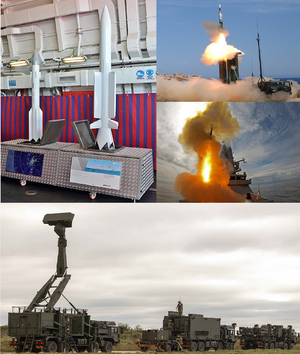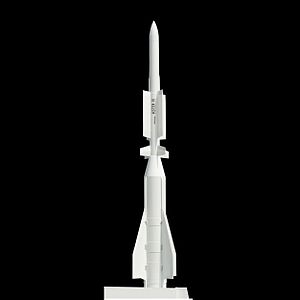Common Air Defense System: Difference between revisions
(Created page with " {{infobox weapon | name = Common Air Defense System | image = CADS_collage.png | caption = Clockwise from left: CADS-S (left) and CADS-M...") |
No edit summary |
||
| Line 106: | Line 106: | ||
}} | }} | ||
The '''Common Air Defense System (CADS)''' is a family of all-weather {{wpl|surface-to-air missile}}s by [[Meridon]] to replace all naval and terrestrial air defense missiles and systems in use by the [[Meridon Defense Forces]]. In use since the 1990s on the [[Meridonian Navy]]'s [[Helena-class destroyers]] and with the [[Meridonian Army]] since 2004, it was developed through the 1980s to serve as a replacement of a variety of different missile systems in use by both services. The missile systems are produced by [[Matca Aerospace]] and are capable of being fired from surface ships as well as ground-based launchers. | The '''Common Air Defense System (CADS)''' is a family of all-weather {{wpl|surface-to-air missile}}s produced and developed by [[Meridon]] to replace all naval and terrestrial air defense missiles and systems in use by the [[Meridon Defense Forces]]. In use since the 1990s on the [[Meridonian Navy]]'s [[Helena-class destroyers]] and with the [[Meridonian Army]] since 2004, it was developed through the 1980s to serve as a replacement of a variety of different missile systems in use by both services. The missile systems are produced by [[Matca Aerospace]] and are capable of being fired from surface ships as well as ground-based launchers. | ||
CADS missiles were designed to be capable of meeting present and future threats, and are capable of intercepting a full spectrum of threats including modern tactical fighter aircraft, UAVs, helicopters, sea-skimming supersonic cruise missiles, UAVs, and ballistic missiles. Later developments of the CADS-M missile have enabled it to intercept high-altitude intercontinental ballistic missiles in the terminal phase as well as hypersonic weaponry in the terminal phase. | CADS missiles were designed to be capable of meeting present and future threats, and are capable of intercepting a full spectrum of threats including modern tactical fighter aircraft, UAVs, helicopters, sea-skimming supersonic cruise missiles, UAVs, and ballistic missiles. Later developments of the CADS-M missile have enabled it to intercept high-altitude intercontinental ballistic missiles in the terminal phase as well as hypersonic weaponry in the terminal phase. | ||
| Line 124: | Line 124: | ||
The CADS family of missiles contains two missiles: Common Air Defense System-Short (CADS-S) for shorter range interceptions and Medium (CADS-M) for longer range and ballistic interception duties. Both missiles, while having externally differing appearances, share a large amount of internals, including their guidance, uplink, communication, warhead, and motor sections. Both variants of CADS missiles are capable of being fired from standardized box launchers and VLS tubes interchangeably and if needed missiles can easily be swapped from naval to ground launchers, or vice versa. Ground launch systems can accommodate both CADS-M and CADS-S on a singular launcher vehicle owing to this method. CADS-S missiles, similarly to older Standard missiles, are capable of being quad-packed in a full-length VLS tube that would normally fit a singular CADS-M missile. | The CADS family of missiles contains two missiles: Common Air Defense System-Short (CADS-S) for shorter range interceptions and Medium (CADS-M) for longer range and ballistic interception duties. Both missiles, while having externally differing appearances, share a large amount of internals, including their guidance, uplink, communication, warhead, and motor sections. Both variants of CADS missiles are capable of being fired from standardized box launchers and VLS tubes interchangeably and if needed missiles can easily be swapped from naval to ground launchers, or vice versa. Ground launch systems can accommodate both CADS-M and CADS-S on a singular launcher vehicle owing to this method. CADS-S missiles, similarly to older Standard missiles, are capable of being quad-packed in a full-length VLS tube that would normally fit a singular CADS-M missile. | ||
In Meridonian service, CADS-S and CADS-M variants are respectively designated MSA-15 and MSA-30 for naval-launched missiles and GSA-15 and GSA-30 for ground-launched missiles. | |||
Export variants exist for these missiles, designated CADS(E), that do not have home on-jam capability, reduced range, and slightly downgraded control systems and in the case of the CADS-M a downgraded booster reducing range to roughly 100 miles. | |||
==Deployment== | ==Deployment== | ||
Revision as of 18:55, 18 June 2023
| Common Air Defense System | |
|---|---|
 Clockwise from left: CADS-S (left) and CADS-M (right) on display, CADS-M (GSA-30) launch from a land battery, CADS-M (MSA-30) launch from a Helena-class destroyer, CADS-S missile battery. | |
| Type | Surface-to-air missile, Anti-ballistic missile |
| Place of origin | |
| Service history | |
| In service | 1989-present |
| Used by | |
| Production history | |
| Designer | Matca Aerospace |
| Produced | 1990-present |
| Variants |
|
| Specifications | |
| Weight | 635 kg (1,400 lb) |
| Length | 4.90 m (16.1 ft) |
| Diameter | 14.1 in (0.36 m) |
| Warhead | 25lb blast fragmentation warhead, with 6ft lethal radius |
Detonation mechanism | Proximity and impact |
| Engine |
|
Operational range |
|
| Flight ceiling |
|
| Speed |
|
Guidance system |
|
Launch platform | surface ships, mobile and fixed missile launchers |
The Common Air Defense System (CADS) is a family of all-weather surface-to-air missiles produced and developed by Meridon to replace all naval and terrestrial air defense missiles and systems in use by the Meridon Defense Forces. In use since the 1990s on the Meridonian Navy's Helena-class destroyers and with the Meridonian Army since 2004, it was developed through the 1980s to serve as a replacement of a variety of different missile systems in use by both services. The missile systems are produced by Matca Aerospace and are capable of being fired from surface ships as well as ground-based launchers.
CADS missiles were designed to be capable of meeting present and future threats, and are capable of intercepting a full spectrum of threats including modern tactical fighter aircraft, UAVs, helicopters, sea-skimming supersonic cruise missiles, UAVs, and ballistic missiles. Later developments of the CADS-M missile have enabled it to intercept high-altitude intercontinental ballistic missiles in the terminal phase as well as hypersonic weaponry in the terminal phase.
The primary operator of the CADS family of missiles is Meridon, where it equips all major surface vessels except for the Taga-class frigates, and the Meridonian Army and Air Forces, where it equips air defense units. CADS missile systems are available for export.
Development history
The CADS family was developed in response to combat experience and operational testing in missile defense primarily from Navy operational experience in the 1960s and 70s with the Standard missile and the observation of emergent threats including those posed by ballistic and hypersonic weaponry targeting Meridonian carrier task groups from threats such as Kaskaida. In 1983, the Defense Forces issued a design contest for a future family of standardized anti-aircraft missiles. Emphasis was put on design commonality between missile systems- both the short to medium range and the long-range missile were to have no less than a 60% part commonality, and the maritime and land-based variations of these missiles should be able to be adapted for launch from one regime to the next by in-field maintenance teams. The missiles were to be capable of conducting interceptions at a minimum of 0.5 nautical miles, out to a maximum of at least 120 nautical miles, and must have a capability to engage targets independently of ground-based targets. A bid from Matca Aerospace was accepted in 1985 with testing commencing in the same year. Testing was completed in 1989 with an operational roll-out and integration with Helena-class destroyers in 1993, where it was extensively tested aboard Helena before she was commissioned.
The Meridonian Army first tested the CADS-M in 1998, and the CADS-S in 2000. The CADS-M entered service in 2001, with the CADS-M entering service in 2004 with air defense artillery battalions, the Air Forces adopting the CADS series in 2004 as well.
Design specifications
The CADS family of missiles contains two missiles: Common Air Defense System-Short (CADS-S) for shorter range interceptions and Medium (CADS-M) for longer range and ballistic interception duties. Both missiles, while having externally differing appearances, share a large amount of internals, including their guidance, uplink, communication, warhead, and motor sections. Both variants of CADS missiles are capable of being fired from standardized box launchers and VLS tubes interchangeably and if needed missiles can easily be swapped from naval to ground launchers, or vice versa. Ground launch systems can accommodate both CADS-M and CADS-S on a singular launcher vehicle owing to this method. CADS-S missiles, similarly to older Standard missiles, are capable of being quad-packed in a full-length VLS tube that would normally fit a singular CADS-M missile.
In Meridonian service, CADS-S and CADS-M variants are respectively designated MSA-15 and MSA-30 for naval-launched missiles and GSA-15 and GSA-30 for ground-launched missiles.
Export variants exist for these missiles, designated CADS(E), that do not have home on-jam capability, reduced range, and slightly downgraded control systems and in the case of the CADS-M a downgraded booster reducing range to roughly 100 miles.
Deployment
The Meridonian Navy was the first to operationally field both CADS-S and CAD-M missiles aboard the Helena-class destroyers, starting with fitting out and testing aboard the lead ship in 1994 and it's first full deployment armed with the missiles in 1996. It fields the missiles on all major surface combatants except for the Taga-class frigates, and the aircraft carriers Sistine and Kohina.
The Meridonian Army fields the missiles in all of its air defense artillery units.
